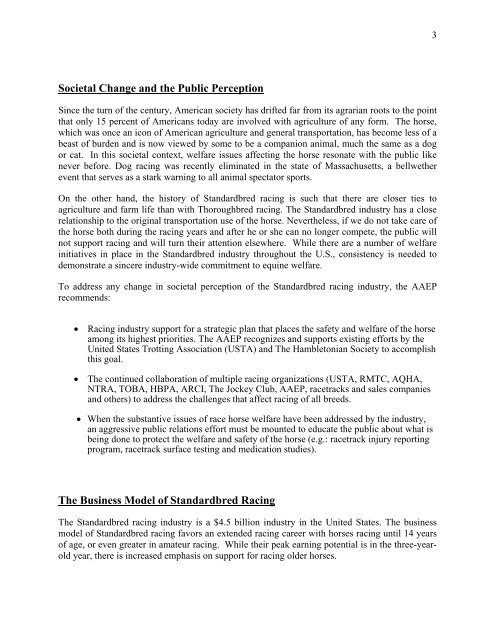Retired Racehorses
tfrr_reportandappendicesfinal
tfrr_reportandappendicesfinal
- No tags were found...
You also want an ePaper? Increase the reach of your titles
YUMPU automatically turns print PDFs into web optimized ePapers that Google loves.
3<br />
Societal Change and the Public Perception<br />
Since the turn of the century, American society has drifted far from its agrarian roots to the point<br />
that only 15 percent of Americans today are involved with agriculture of any form. The horse,<br />
which was once an icon of American agriculture and general transportation, has become less of a<br />
beast of burden and is now viewed by some to be a companion animal, much the same as a dog<br />
or cat. In this societal context, welfare issues affecting the horse resonate with the public like<br />
never before. Dog racing was recently eliminated in the state of Massachusetts, a bellwether<br />
event that serves as a stark warning to all animal spectator sports.<br />
On the other hand, the history of Standardbred racing is such that there are closer ties to<br />
agriculture and farm life than with Thoroughbred racing. The Standardbred industry has a close<br />
relationship to the original transportation use of the horse. Nevertheless, if we do not take care of<br />
the horse both during the racing years and after he or she can no longer compete, the public will<br />
not support racing and will turn their attention elsewhere. While there are a number of welfare<br />
initiatives in place in the Standardbred industry throughout the U.S., consistency is needed to<br />
demonstrate a sincere industry-wide commitment to equine welfare.<br />
To address any change in societal perception of the Standardbred racing industry, the AAEP<br />
recommends:<br />
• Racing industry support for a strategic plan that places the safety and welfare of the horse<br />
among its highest priorities. The AAEP recognizes and supports existing efforts by the<br />
United States Trotting Association (USTA) and The Hambletonian Society to accomplish<br />
this goal.<br />
• The continued collaboration of multiple racing organizations (USTA, RMTC, AQHA,<br />
NTRA, TOBA, HBPA, ARCI, The Jockey Club, AAEP, racetracks and sales companies<br />
and others) to address the challenges that affect racing of all breeds.<br />
• When the substantive issues of race horse welfare have been addressed by the industry,<br />
an aggressive public relations effort must be mounted to educate the public about what is<br />
being done to protect the welfare and safety of the horse (e.g.: racetrack injury reporting<br />
program, racetrack surface testing and medication studies).<br />
The Business Model of Standardbred Racing<br />
The Standardbred racing industry is a $4.5 billion industry in the United States. The business<br />
model of Standardbred racing favors an extended racing career with horses racing until 14 years<br />
of age, or even greater in amateur racing. While their peak earning potential is in the three-yearold<br />
year, there is increased emphasis on support for racing older horses.


